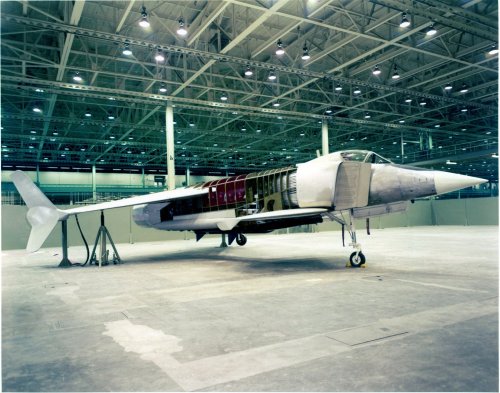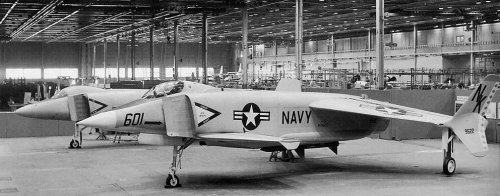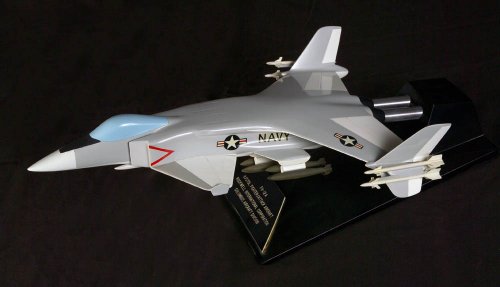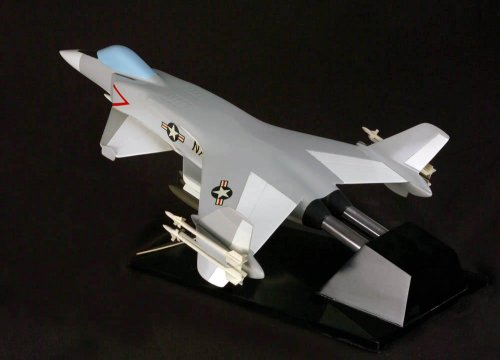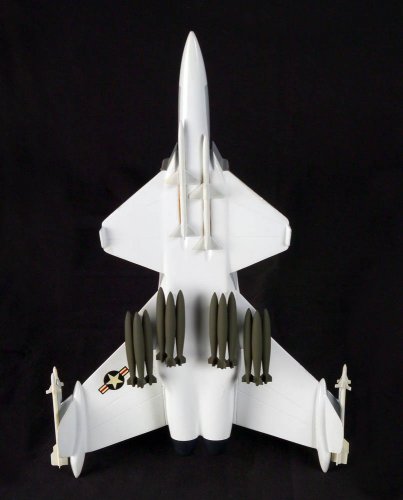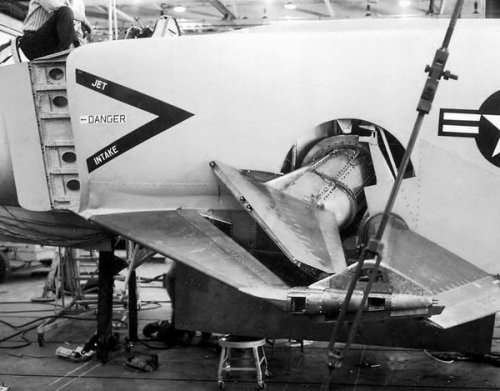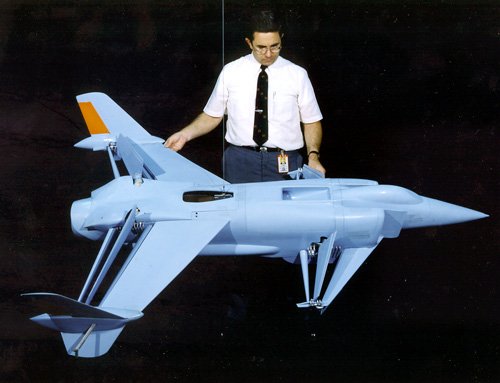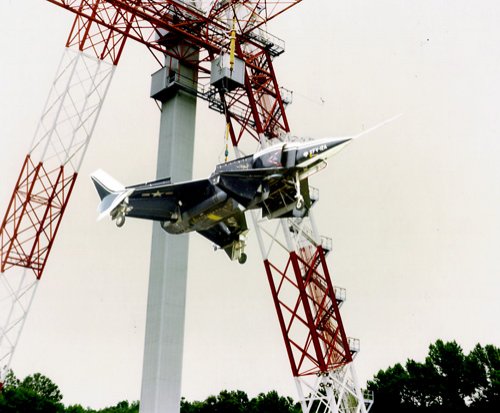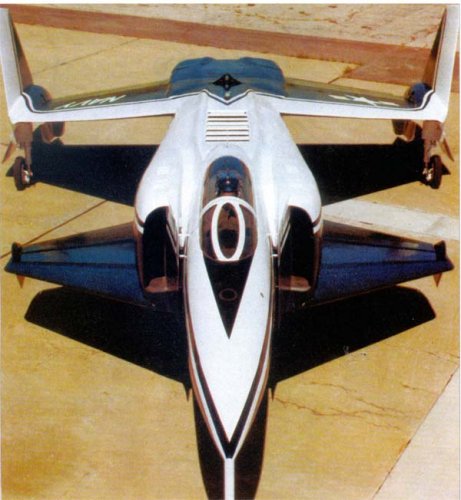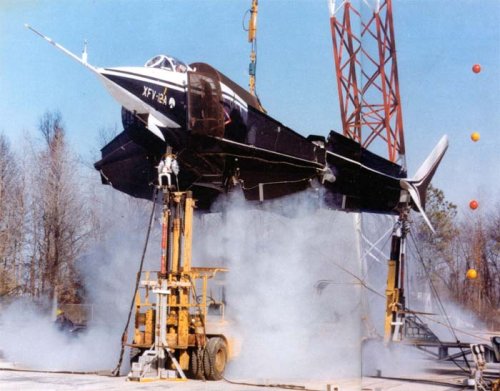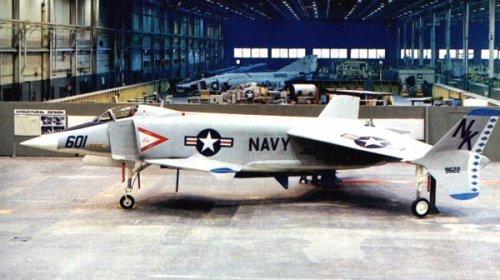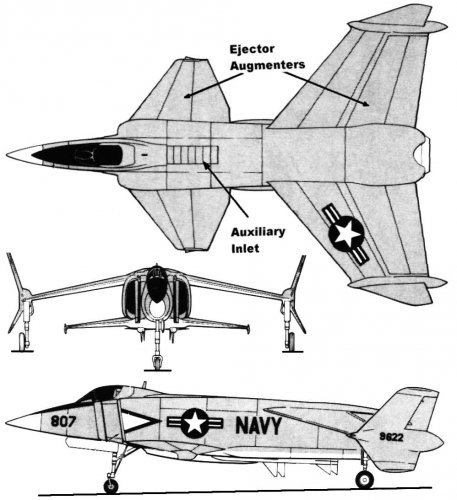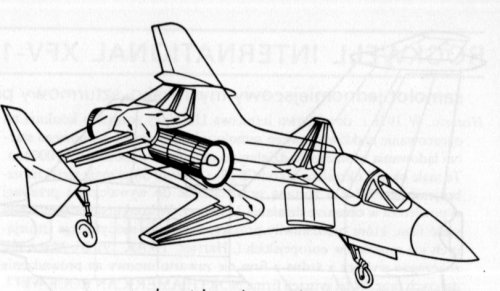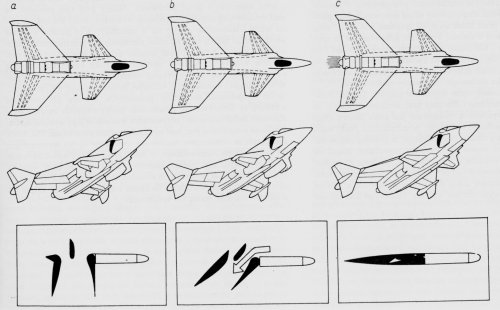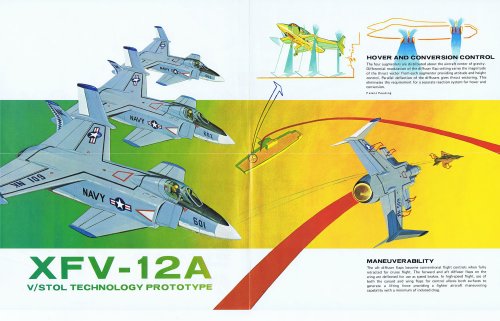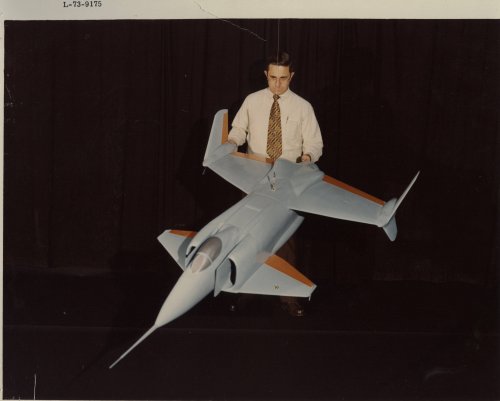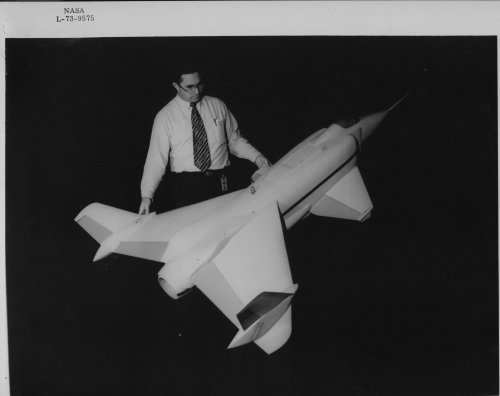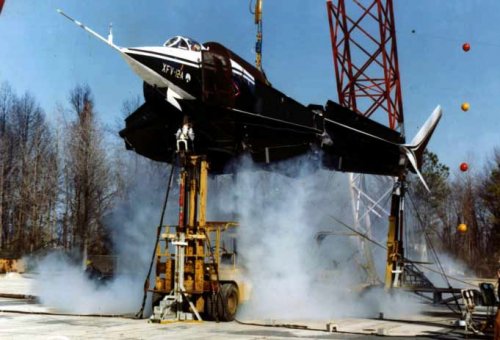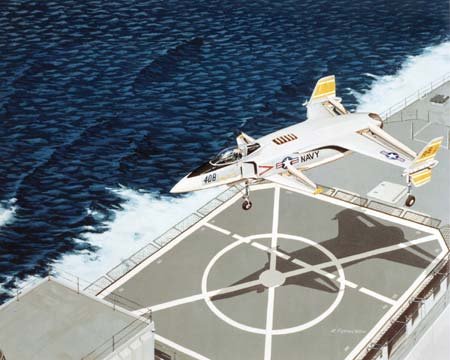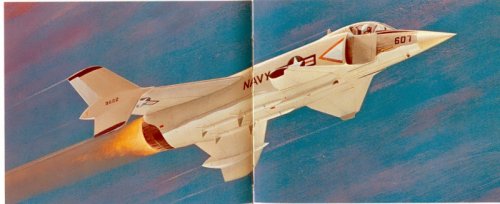You are using an out of date browser. It may not display this or other websites correctly.
You should upgrade or use an alternative browser.
You should upgrade or use an alternative browser.
Rockwell NR-356 Sea Control Ship (SCS) V/STOL fighter (XFV-12A)
- Thread starter KnightTemplar
- Start date
- Joined
- 1 April 2006
- Messages
- 11,402
- Reaction score
- 10,332
I'm not sure about true colors original mockup photo - it has even more odd colors. Hope that Overscan will get better results with playing color sets when Xmas rush will end.
http://www.up-ship.com/drawndoc/drawndocair.htm#airdwg36


- Joined
- 27 December 2005
- Messages
- 17,755
- Reaction score
- 26,471
- Joined
- 13 August 2007
- Messages
- 8,463
- Reaction score
- 11,066
overscan said:hmmm.... The colours in the original are so odd its hard to know what they were supposed to be. This looks better to me, but accurate? Probably not.
my guess
1 its a bad Scan
2 the original photo is from 1977 and after 30 years the colors has faded
- Joined
- 13 August 2007
- Messages
- 8,463
- Reaction score
- 11,066
flateric said:Michel, point 2 in fact
I was scanning it myself from original
In that case the Scan is first class Flateric Quality B) B) B)
by the way
is on the original photo any Information on material and developer used for it ?
My guess is that it was painted an aluminum color to match the A4D's aluminum nose. I saw that picture back in the day in black and white and it had the same appearance.flateric said:I'm not sure about true colors original mockup photo - it has even more odd colors. Hope that Overscan will get better results with playing color sets when Xmas rush will end.
The other side of this mockup had a full exterior and was painted completely as shown here.
Attachments
- Joined
- 13 August 2007
- Messages
- 8,463
- Reaction score
- 11,066
Tailspin Turtle said:My guess is that it was painted an aluminum color to match the A4D's aluminum nose. I saw that picture back in the day in black and white and it had the same appearance.
The other side of this mockup had a full exterior and was painted completely as shown here.
makes sense because back in 1977
the U.S. NAVY used aluminum color on their aircrafts
example this F-14 around same time
http://upload.wikimedia.org/wikipedia/commons/thumb/6/68/F-14-vf-84.jpg/800px-F-14-vf-84.jpg
Steve Pace
Aviation History Writer
- Joined
- 6 January 2013
- Messages
- 2,266
- Reaction score
- 225
Anybody know the model number (NA- or NR- number)of the XFV-12A?
Steve Pace
Aviation History Writer
- Joined
- 6 January 2013
- Messages
- 2,266
- Reaction score
- 225
- Joined
- 25 June 2009
- Messages
- 14,758
- Reaction score
- 6,164
XB-70 Guy said:Anybody know the model number (NA- or NR- number)of the XFV-12A?
Yep, of course, it was the NR-356.
- Joined
- 26 January 2011
- Messages
- 2,226
- Reaction score
- 645
I was under the impression that this thing never really flew more than a few feet above the ground yet those pictures show it quite high up. Or are they hoisting it that high with the rig around it?
- Joined
- 8 January 2006
- Messages
- 1,612
- Reaction score
- 763
True, I'm not even certain it even made any conventional flights. I do remember NAR-Columbus visiting P&W-Florida for assistance in trying to sort the problems out.Stargazer2006 said:I think they are, yes. Tethered flight only. The XFV-12A never flew on its own.
Chad Slattery
ACCESS: Restricted
- Joined
- 6 November 2009
- Messages
- 3
- Reaction score
- 0
For a story in Air & Space magazine, I tried to find out what happened to the aircraft. Anybody know? Is it tucked away somewhere? Was it scrapped? I could never find the answer. Without an answer, there was no story. In a similar vein, I tried to track down whatever happened to the original negative of the famous shot Bob Hoover made of Yeager's X-1 as it shot past him on October 14, 1947. Spent two years on that--never found it.
I started on a profile illustration of that. I might have to finish it after I'm done with this Leduc 020.
"For a story in Air & Space magazine, I tried to find out what happened to the aircraft. Anybody know? Is it tucked away somewhere? Was it scrapped? I could never find the answer. Without an answer, there was no story. In a similar vein, I tried to track down whatever happened to the original negative of the famous shot Bob Hoover made of Yeager's X-1 as it shot past him on October 14, 1947. Spent two years on that--never found it." the last I heard she had been scraped to save hanger space with only the forward fuselage remaining
- Joined
- 13 June 2007
- Messages
- 2,173
- Reaction score
- 3,096
Greetings All -
I have had a brochure about the XFV-12 that a docent at the long closed Ohio Museum of Flight in Columbus gave me when i visited there back in the mid-90s. I recently uncovered it and scanned it.
Enjoy the Day! Mark
I have had a brochure about the XFV-12 that a docent at the long closed Ohio Museum of Flight in Columbus gave me when i visited there back in the mid-90s. I recently uncovered it and scanned it.
Enjoy the Day! Mark
Attachments
- Joined
- 1 April 2006
- Messages
- 11,402
- Reaction score
- 10,332
Lesson here is, don't mess with the Harrier 
Got to be fairly crushing being a dev engineer on this project, taking it all the way to full-scale only to find it will only generate downward thrust equivalent to 75% of the airframe mass...
Got to be fairly crushing being a dev engineer on this project, taking it all the way to full-scale only to find it will only generate downward thrust equivalent to 75% of the airframe mass...
I understand that at full scale it had disappointing performance, but the tunnel and model tests had to have been good enough to attempt the move to full scale. Is it direct scaling issue relative to the ducts used (associated friction drag, etc), or reynold's number weirdness with the amount of augmentation experienced, or something else that was the dominant cause of the disappointing performance?
The reason why I ask, is that if it is a scaling issue of sorts, that means augmented wing setups may be viable for small size UAV's. I also wonder if the same effects are occurring in that Dyson air multiplier fan. Which could lead one to ponder a dual or quad shrouded rotor UAV, except it would be just shrouds and no actual rotors, all being fed by a central compressor/engine.
The reason why I ask, is that if it is a scaling issue of sorts, that means augmented wing setups may be viable for small size UAV's. I also wonder if the same effects are occurring in that Dyson air multiplier fan. Which could lead one to ponder a dual or quad shrouded rotor UAV, except it would be just shrouds and no actual rotors, all being fed by a central compressor/engine.
If it had worked, I wonder if the XFV-12A project would have been killed anyway by the forces who wanted large nuclear aircraft carriers for the US Navy. It's a much more difficult job to advocate through-deck cruisers such as the SCS, VSS, or CVV, when the V/STOL fighter solution doesn't work.
Well, the big problem is that you also need to fly AEW, ASW, and cargo aircraft. The mini-carriers are restricted to V/STOL aircraft.
The U.S. Navy commissioned several design studies for V/STOL AEW/ASW aircraft in the late 1970s. None were terribly appealing.
The U.S. Navy commissioned several design studies for V/STOL AEW/ASW aircraft in the late 1970s. None were terribly appealing.
Mike OTDP said:Well, the big problem is that you also need to fly AEW, ASW, and cargo aircraft. The mini-carriers are restricted to V/STOL aircraft.
The U.S. Navy commissioned several design studies for V/STOL AEW/ASW aircraft in the late 1970s. None were terribly appealing.
The eight Sea Control Ships (SCS) were originally intended to operate the Sea Harrier, or a variant thereof, and ASW helicopters. Their mission was to provide escort for Atlantic merchant convoys on their way to England from Soviet submarines and attacks by anti-ship missile equipped aircraft such as long range bombers. To save money, they were originally intended to be built to merchant ship standards as opposed to military standards. They were intended to supplement the existing CVN carrier battle groups and free these ships from merchant shipping escort duty. The aircraft component of these ships was never intended to duel with front-line Soviet fighters.
The concept was rejected by Congress because the ships couldn't do much more than escort and they became larger and more capable. Evolving from the SCS to the V/STOL Support Ship (VSS). Over time, the aircraft intended to operate on these V/STOL carriers became more and more capable. The VSS concept would then grow again into the CVV, a conventional-powered through-deck aviation cruiser that was being sold as a less-expensive and capable alternative to the nuclear-powered CVNs. When this happened, the CVV got in the cross hairs of the nuclear-powered CVN lobby who killed the concept because it was a threat to the building of more Nimitz-class carriers. The V/STOL aircraft required to operate on the smaller flight decks turned out to be more complicated and expensive to develop than the existing aircraft types already operating on the CVNs.
- Joined
- 1 April 2006
- Messages
- 11,402
- Reaction score
- 10,332
Tethered-Hover Test of the XFV-12A
In early 1978, a team of NASA, Navy, and North American
Rockwell personnel performed tethered-hover tests of
the full-scale XFV-12A at the IDRF. A photograph of the
XFV-12A during a tethered hover test is shown in Figure
7. Some fairly extensive modifications were made to the
IDRF to allow tethered-hover tests for powered vertical
take-off and landing aircraft. During six months of testing of
the XFV-12A, major deficiencies were apparent in hovering
flight, including marginal thrust augmentation and relatively
poor handling qualities. The findings from this test program
helped influence the Navy's decision to cancel the XFV-12A
program [9].
A History of Full-Scale Aircraft and Rotorcraft Crash Testing and Simulation
at NASA Langley Research Center
http://hdl.handle.net/2060/20040191337
In early 1978, a team of NASA, Navy, and North American
Rockwell personnel performed tethered-hover tests of
the full-scale XFV-12A at the IDRF. A photograph of the
XFV-12A during a tethered hover test is shown in Figure
7. Some fairly extensive modifications were made to the
IDRF to allow tethered-hover tests for powered vertical
take-off and landing aircraft. During six months of testing of
the XFV-12A, major deficiencies were apparent in hovering
flight, including marginal thrust augmentation and relatively
poor handling qualities. The findings from this test program
helped influence the Navy's decision to cancel the XFV-12A
program [9].
A History of Full-Scale Aircraft and Rotorcraft Crash Testing and Simulation
at NASA Langley Research Center
http://hdl.handle.net/2060/20040191337
Attachments
sferrin said:One can't help but wonder how things might have turned out had they selected the Convair 200 to pursue instead of the XFV-12.
Well, the Yak 36 and 41 worked - the type 200 certainly looks like workable, at least more than the XVF-12.
Colonial-Marine
UAVs are now friend, drones are the real enemy.
- Joined
- 5 October 2009
- Messages
- 1,475
- Reaction score
- 1,331
Were there any solutions proposed for the XFV-12A or did the engineers involved conclude they had hit a dead end?
Was the engined used in testing an actual P&W F401? I had thought only the original F-14B tested that.
Was the engined used in testing an actual P&W F401? I had thought only the original F-14B tested that.
Artist's impression of Rockwell XFV-12 from NASA Glenn Research Center ImageNet.
Source:
http://grcimagenet.grc.nasa.gov/share/scr_stillimages_detail.cfm?year=1980&cnumber=1445&c_numbertextdisplay=C-1980-1445&dis_opts=shoicons&maxcnumber=3719&maxcyear=1980
Source:
http://grcimagenet.grc.nasa.gov/share/scr_stillimages_detail.cfm?year=1980&cnumber=1445&c_numbertextdisplay=C-1980-1445&dis_opts=shoicons&maxcnumber=3719&maxcyear=1980
Attachments
- Joined
- 3 June 2006
- Messages
- 3,094
- Reaction score
- 3,966
The Coanda Project
ACCESS: Restricted
- Joined
- 14 March 2012
- Messages
- 2
- Reaction score
- 1
All,
This is a great thread. I'd like to add something to it that you all may be interested in:
http://www.nasa.gov/offices/oce/appel/ask-academy/issues/volume4/ata_4-8_maciej_zborowski.html
The Coanda Project is coming along and now has trades students working on the restoration team. As this is the most extensive forum regarding the XFV12A that I have come across, I will post updates here.
This is a great thread. I'd like to add something to it that you all may be interested in:
http://www.nasa.gov/offices/oce/appel/ask-academy/issues/volume4/ata_4-8_maciej_zborowski.html
The Coanda Project is coming along and now has trades students working on the restoration team. As this is the most extensive forum regarding the XFV12A that I have come across, I will post updates here.
- Joined
- 27 December 2005
- Messages
- 17,755
- Reaction score
- 26,471
A worthy project - it might not have succeeded but its an interesting bit of aviation heritage.
Similar threads
-
REQUIREMENT: US Navy VFA - V/STOL Fighters for Sea Control Ships
- Started by overscan (PaulMM)
- Replies: 5
-
MOVED: Rockwell NR-356 Sea Control Ship (SCS) V/STOL fighter (XFV-12A)
- Started by Stargazer
- Replies: 0
-
Rockwell NA-420, NA-430 and NA-431 (US Navy "Type A" proposals)
- Started by overscan (PaulMM)
- Replies: 13
-
-
NA/Rockwell 70's Stealth: Flying Banana, Silent Attack & Surprise Fighter
- Started by overscan (PaulMM)
- Replies: 51

